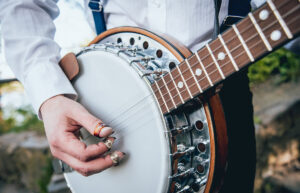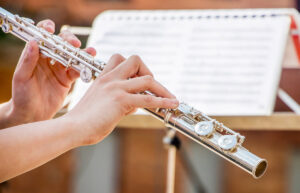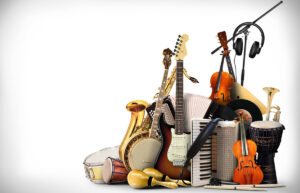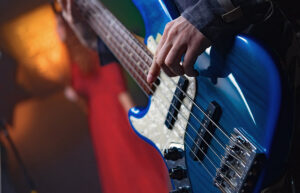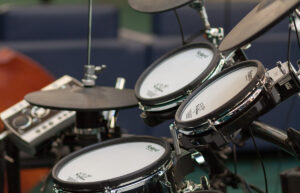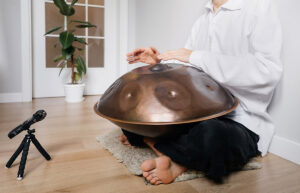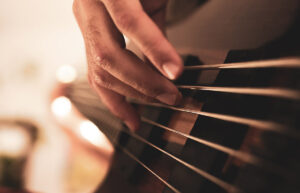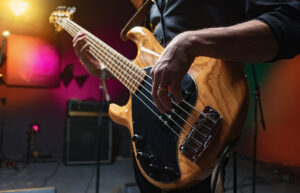How To Hold a Guitar? Tips for Beginners

Are you ready to master the art of how to hold a guitar? You are at the right place. Our comprehensive guide emphasizes the importance of proper guitar holding in developing fundamental skills and playing comfortably and quickly with the correct technique. It provides comprehensive instructions for properly holding a guitar to improve your guitar-playing experience.
Let us examine the essential tips for beginners on how to hold a guitar with expert advice.
Steps To Hold a Guitar
1: Overall Guitar/Body Alignment
- To ensure proper hand and arm positions while playing guitar, hold the guitar body close to your body, including the bottom.
- Beginners frequently let the guitar slide away to improve fingerboard visibility.
- To avoid awkward positions, tuck the guitar body in and sit up straighter, tilting the guitar towards the ceiling.
2: Rest the Guitar on Your Right Leg
- The traditional way to play an acoustic or electric guitar is to place it on the right leg. It is recommended for beginners as it allows the body to maintain its natural posture and muscular alignment.
- However, resting on a left leg can result in a hunched back and an overextended left forearm, making the left hand’s fingers unnaturally fit.
3: How To Hold the Pick
Holding the guitar pick requires a balance of tightness and flexibility.
- Hold the pick between your thumb and the side of your index finger. The pointed end should be sticking out slightly.
- The wrist should be neutral and non-flexed, with the top of the wrist aligned with the forearm. This position allows the wrist to rotate naturally without causing unnecessary tension.
- When the pick and thumb are pointed towards the strings, it can cause awkward angles, picking and strumming issues, and a sore wrist.
4: Left Arm and Hand Position
- To effectively play a guitar, keep your left arm and hand relaxed, allowing your hand to easily reach notes across the fretboard.
- One important habit is to keep your thumb behind the guitar’s neck, which allows you to position your fingers correctly on the fretboard and reach notes and chords.
Additional tip: Wrapping your thumb around the guitar’s neck or extending it parallel are common beginner mistakes, so you need to avoid doing this.
Implementing these tips will help you learn how to hold a guitar, and improve your guitar-playing experience.
5: Use Your Right Arm to Stabilize the Guitar
- Keep your right arm on the instrument when playing an acoustic guitar to provide stability and control.
- When playing an electric guitar, your arm should come slightly over the top and rest on the front, allowing you to access the strings and controls easily.
6: Make Sure Your Fretting Hand Isn’t Holding up the Guitar
- Your thigh and right arm should support the guitar, not your fretting hand.
- The guitar should be stable without requiring your fretting hand, and you should be able to quickly move your hand up and down the neck.
Additional tip: Form a “V” shape with your fretting hand’s thumb and forefinger to balance the guitar neck.
7: Don’t Lean the Guitar Back Toward You
- Beginners frequently need to correct the mistake of leaning the guitar towards themselves, which causes unnecessary tension and makes it difficult to reach around the neck.
- To avoid this, sit up straight and place the guitar comfortably without straining your hand or wrist. It will help you develop good technique and avoid potential injuries during practice.
Additional tip: Avoid leaning the guitar back excessively to see the fretboard. Instead, trust your muscle memory and practice.
8: Be Aware of Your Posture
Beginners should practice guitar playing in a sitting position to learn how to hold a guitar comfortably without straining to reach the frets and strings.
- Back straight: Maintain a straight back to avoid slouching. This posture helps prevent back pain and promotes better technique.
- Shoulders relaxed: Keep your shoulders relaxed and not hunched towards your ears.
- Neck alignment: Keep your head upright. Avoid looking down too much to prevent neck strain.
Additional tip: Use hard-backed chairs with no armrests or stools instead of soft recliners.
FAQs
How to hold your guitar properly?
Learn the necessary steps for holding a guitar properly.
- Overall guitar/body alignment
- Rest the guitar on your right leg
- How to hold the pick
- Left arm and hand position
- Use your right arm to stabilize the guitar
- Make sure your fretting hand isn’t holding up the guitar
- Don’t lean the guitar back towards you
- Be aware of your posture
What is the most comfortable position to play the guitar?
The most comfortable position to play the guitar is sitting upright with the guitar resting on your right leg, supported by your right arm, and maintaining good posture.
How should I place my fingers on a guitar?
To position your fingers on a guitar, follow these steps:
- Relax your wrist
- Grip the neck in the “C” formed between your thumb and fingers
- Curl your fingers
- Keep them close to the fretboard for speed and precision
- Use your thumb for power and stability
- Rotate your wrist for better movement on the fretboard while playing guitar
How to hold a fretting hand?
- Thumb position: Place your thumb behind the neck, roughly in the middle, acting as a pivot.
- Finger curvature: Curve your fingers and position them perpendicular to the fretboard.
- Finger placement: Press down just behind the frets for clear notes.
- Relaxation: Keep your hand relaxed and avoid unnecessary tension.







